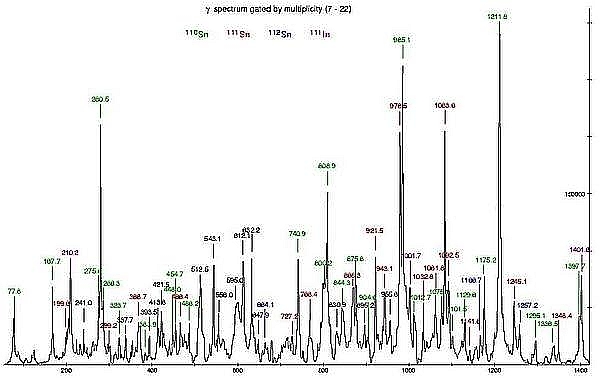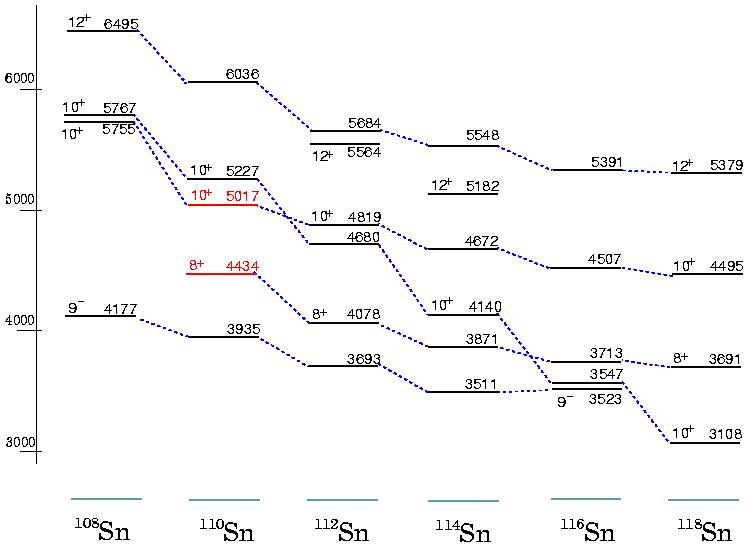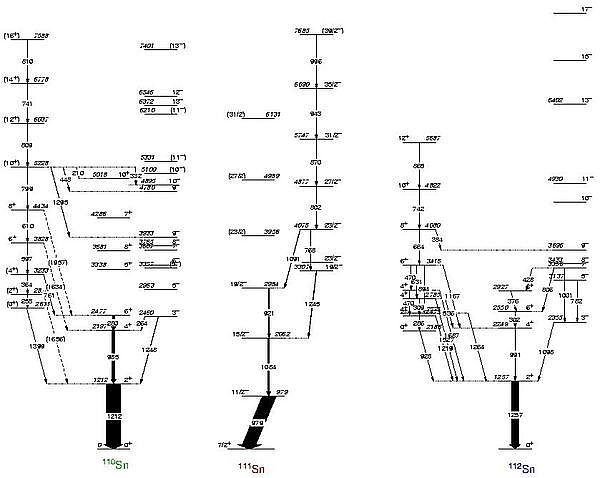Spektroskopia Gamma
Wersja polska w przygotowaniu…
Gamma-ray spectroscopy in Sn isotopes
Heavy Ion Laboratory, Warsaw University
J.Kownacki, M.Wolińska-Cichocka, J.Iwanicki, A.Kordyasz, P.Napiorkowski, M.Palacz, A.Stolarz
The A. Sołtan Institute for Nuclear Studies, Świerk
M.Kisieliński, W.Płóciennik, E.Ruchowska
Nuclear Physics Division, Warsaw University
Ch.Droste, M.Kowalczyk, T.Morek, J.Srebrny, W.Urban
Department of Physics, University of Łódź
J.Perkowski
Department of Physics, Silesia University, Katowice
B.Bekman, P.Kowina
The H.Niewodniczański Institute of Nuclear Physics, Kraków
W.Męczyński, J.Styczeń
Institut für Kernphysik, Forschungszentrum, Jülich
W.Gast, R.Lieder
Excited states in 110Sn and 111Sn nuclei have been investigated using in-beam γ-ray spectroscopic methods. An 16O beam with energy of 60-80 MeV was used to bombard a 98Mo target. On the basis of the relative excitation functions, γ -ray angular distributions, γ–γ and γ-ray multiplicity and total energy data the level schemes of 110Sn and 111Sn have been reinvestigated and extended up to Eexc~11.5 MeV, I=24ħ, and Eexc~11.1 MeV and I=(51/2)ħ, respectively. An extension of the intruder, g.s. and negative parity bands in 110Sn in low-spin region as well as 5 new band-like structures are proposed. In the 111Sn nucleus an intruder band based on 23/2– state has been reinvestigated and the extension of the g.s. band and second negative parity band is given. An evidence for neutron-core coupling in 111Sn is found.
In this experiments OSIRIS-II was equipped with 10 HPGe Compton suppressed spectrometers combined with 48-element BGO multiplicity filter. The HPGe’s were surrounding the filter, about 17 cm from the target and the BGO crystals served as collimators for the Ge detectors. Events were accepted by the data acquisition system if at least two coincident γ rays were detected in the Ge detectors. A total amount of 8×107γγ-coincidence events was recorded in the coincidence experiment. The compound nucleus 114Sn was favouring the evaporation of neutrons, hence the main reaction products were 110Sn (4n), 111Sn (3n) and 112Sn (2n).
The main reaction channels obtained in 16O + 98Mo reaction at 80MeV beam energy are shown below. This γ spectrum is gated by multiplicity from 7 to 22. Various colors correspond to different reaction products. For 110Sn it’s green, the red for 111Sn, blue for 112Sn and violet for 111In.

These experiments have confirmed levels reported previously for 110Sn, 111Sn and 112Sn [1 2, 5] and several new levels were identified. In the level scheme of 110Sn we proposed four new side bands (including M1-transition band). Moreover, the negative parity band was extended. For 111Sn two bands were extended, too.
The partial level schemes of 110Sn, 111Sn and 112Sn presenting the intruder bands are shown below.
These are positive parity bands in 110Sn and 112Sn, and negative parity band in 111Sn.
The ordering of transitions is based on relative γ-ray intensities and coincidence relationships. The transition intensities were determined using ESCL8R program [4]. Analysis of these data enabled a detailed level scheme to be established for the lower-spin states in intruder band (below the 5228 keV state). The level having an excitation energy of 5018 keV, intepreted as Iπ=10+ state was observed for the first time in this work. The new levels proposed for 110Sn are in agreement with the level systematics of corresponding states in neighbouring even-Sn nuclei (see on figure below). 
These data confirmed that the level energies of states in the intruder band increase with decreasing neutron number [3].
- D.R. LaFosse et al., Phys. Rev. C51, R2876 (1995)
- H. Harada et al., Phys. Let. B207, 17 (1988)
- S. Juutinen et al., Nucl. Phys. A617, 74 (1997)
- D.C. Radford, Nucl. Inst. Meth. A361, 290 (1995)
- D.A. Viggars et al., Phys. Rev. C36, 1006 (1987)
Further information on experiment, data analysis and results are available here.(as a PDF file)


